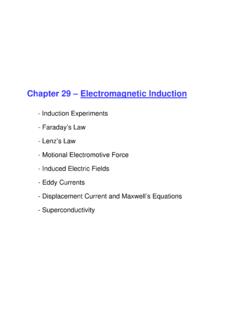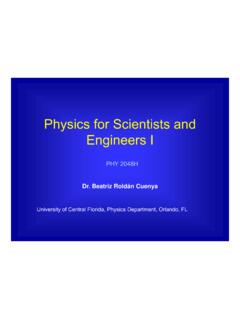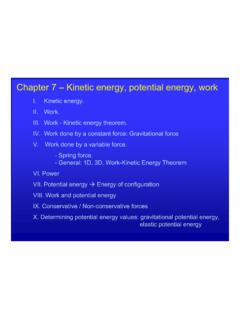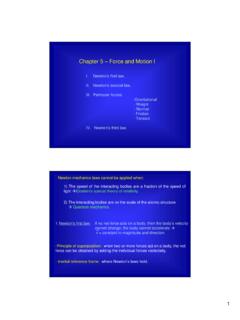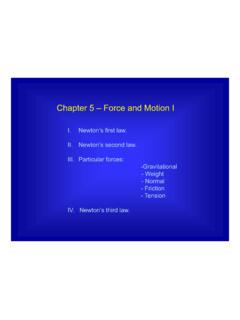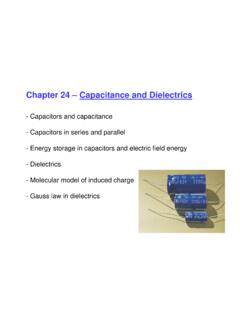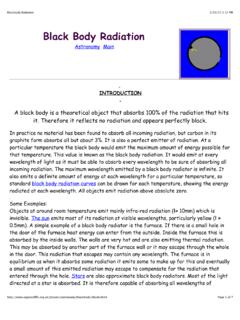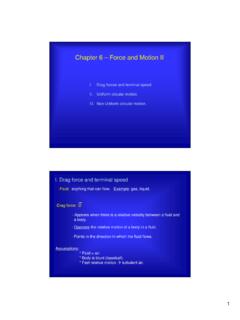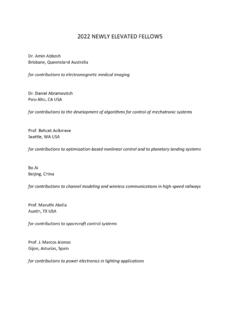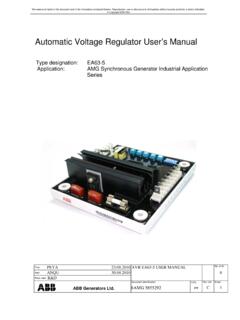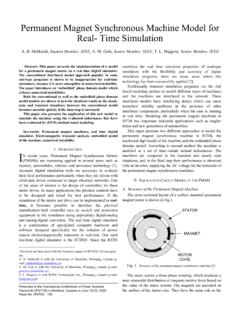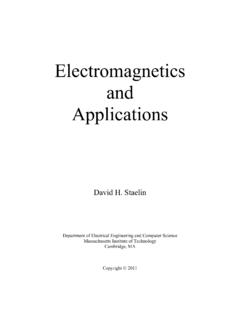Transcription of Chapter 27 – Magnetic Field and Magnetic Forces
1 Chapter 27 Magnetic Field and Magnetic Forces - Magnetism- Magnetic Field - Magnetic Field Lines and Magnetic Flux- Motion of Charged Particles in a Magnetic Field - Applications of Motion of Charged Particles- Magnetic Force on a Current-Carrying Conductor- Force and Torque on a Current Loop1) A moving charge or collection of moving charges ( electric current) produces a Magnetic Field . (Chap. 28).2) A second current or charge responds to the Magnetic Field andexperiences a Magnetic force. (Chap. 27).1. MagnetismPermanent magnets: exert Forces on each other as well as on unmagnetizedFe pieces. - The needle of a compass is a piece of magnetized Fe.
2 - If a bar-shaped permanent magnet is free to rotate, one end points north (north pole of magnet ).- An object that contains Fe is not by itself magnetized, it can be attracted by either the north or south pole of permanent A bar magnet sets up a Magnetic Field in the space around it and a second body responds to that Field . A compass needle tends to align with the Magnetic Field at the needle s Magnetism- Magnets exert Forces on each other just like charges. You can draw Magnetic Field lines just like you drew electric Field Magnetic north and south pole s behavior is not unlike electric magnets, like poles repel and opposite poles A permanent magnet will attract a metal like iron with either the north or south poles about our planet- We observed monopoles in electricity.
3 A (+) or (-) alone was stable, and Field lines could be drawn around Magnets cannot exist as monopoles. If you break a bar magnet between N and S poles, you get two smaller magnets, each with its own N and S declination / Magnetic variation:the Earth s Magnetic axis is not parallel to its geographic axis (axis of rotation) a compass reading deviates from geographic inclination:the Magnetic Field is not horizontal at most of earth s surface, its angle up or down. The Magnetic Field is vertical at Magnetic Poles versus Electric Charge-In 1820, Oerstedran experiments with conducting wires run near a sensitive compass.
4 The orientation of the wire and the direction of the flow both moved the compass / Faraday / Henry moving a magnet near a conducting loop can induce a The Magnetic Forces between two bodies are due to the interaction between moving electrons in the Inside a magnetized body( permanent magnet ) there is a coordinated motion of certain atomic electrons. Not true for unmagnetized Magnetic FieldElectric Field :1) A distribution of electric charge at rest creates an electric Field E in the surrounding ) The electric Field exerts a force FE= q E on any other charges in presence of that Field :1) A moving charge or current creates a Magnetic Field in the surrounding space (in addition to E).
5 2) The Magnetic Field exerts a force Fmon any other moving charge or current present in that Field . - The Magnetic Field is a vector Field vector quantity associated with each point in space. sinBvqBvqFm== BvqFm =- Fmis always perpendicular to B and v. 2. Magnetic FieldInteraction of Magnetic force and charge- The moving charge interacts with the fixed magnet . The force between them is at a maximum when the velocity of the charge is perpendicular to the Magnetic Hand RulePositive chargemoving in Magnetic Field direction of force follows right hand ruleNegative charge F directioncontrary to right hand rule.
6 =vBqFUnits:1 Tesla = 1 N s / C m = 1 N/A m1 Gauss = 10-4 TRight Hand RuleIf charged particle moves in region where both, E and B are present:)(BvEqF +=Measuring Magnetic Fields with Test Charges- In general, if a Magnetic Field (B) is present, the electron beam is deflected. However this is not true if the beam is // to B ( = 0, F=0 no deflection).Ex:electron beam in a cathode X-ray deflection F = 0 v // BDeflection F 0 F v, BElectron q< 0 F has contrary direction to righthand rule- Magnetic Field lines may be traced from N toward S (analogous to the electric Field lines).- At each point they are tangent to Magnetic Field The more densely packed the Field lines, the stronger the Field at a Field lines never Magnetic Field Lines and Magnetic Flux- The Field lines point in the same direction as a compass (from N toward S).
7 - Magnetic Field lines are not lines of force . - Magnetic Field lines have no ends they continue through the interior of the Flux and Gauss s Law for Magnetism = == AdBdABdABB cos- Magnetic flux is a scalar If B is uniform: cosBAABB== 0= = AdBB Units: 1 Weber (1 Wb = 1 T m2 = 1 N m / A)- Difference with respect to electric flux the total Magnetic flux througha closed surface is always zero. This is because there is no isolatedmagnetic charge ( monopole ) that can be enclosed by the Gaussian surface. - The Magnetic Field is equal to the flux per unit area across an area at right angles to the Magnetic Field = Magnetic flux density.
8 =dAdBB4. Motion of Charged Particles in a Magnetic FieldBqmvR=BvqFm =- Magnetic force perpendicular to v it cannot change themagnitude of the velocity, only its direction. - F does not have a component parallel to particle s motion cannot do Motion of a charged particle under the action of a Magnetic Field alone is always motion with constant speed. - Magnitudes of F and v are constant (v perp. B) uniformcircular =Radius of circular orbitin Magnetic Field : + particle counter-clockwise particle clockwise charged particle will move in a plane perpendicular to the Magnetic If v is not perpendicular to B v//(parallel to B) constant because F//= 0 particle moves in a helix.
9 (R same as before, with v = v ).Cyclotron frequency: f = /2 Angular speed: = v/R mBqmvBqv== 5. Applications of Motion of Charged ParticlesVelocity selectorSource of charged particles- Particles of a specific speed can be selected from the beam using an arrangement of E and B Fm( Magnetic ) for + charge towards right (q v B).- FE (electric) for + charge to left (q E).- Fnet= 0 if Fm= FE -qE + q v B = 0 v = E/B- Only particles with speed E/B can pass through without being deflected by the s e/mExperiment E = K + U =0 m v2= U = e V222 VBEme=meVBEv2==e/m does not depend on the cathode material or residual gas on tube particles in the beam (electrons) are a common constituent of all Spectrometer- Using the same concept as Thompson, Bainbridge was able to construct a device that would only allow one mass in flight to reach the detector.
10 - Velocity selector filters particles with v = E/B. After this, in the region of B particles with m2 > m1travel with radius (R2 > R1).'BqmvR=6. Magnetic Force on a Current-Carrying Conductor- Total force: BvqFdm =))((BqvnAlFdm=BqvFdm=Force on one chargen = number of charges per unit volumeA l= volume IlBlBJAlBAnqvFdm===))(())()(((B wire)In general: sinIlBIlBF== Magnetic force on a straight wire segment:BlIF = Magnetic force on an infinitesimal wire section:BlIdFd =- Current is not a vector. The direction of the current flow is given by dl, not I. dl is tangent to the =7. Force and Torque on a Current Loop- The net force on a current loop in a uniform Magnetic Field is zero.
